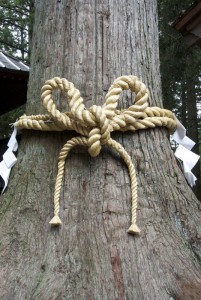Shrines and temples offer contact with Japan’s superb folk spirituality (by Kevin Short)

By Kevin Short / Special to The Japan News
As readers of this column know all too well, I am a great fan and proponent of small, local Japanese shrines and temples.These little sacred spots are often totally unknown outside their own very limited parish area, but they are deeply loved and almost always well taken care of by the people. They offer a great chance for direct, base-level contact not only with the wildlife and old trees of the sacred groves, but with Japan’s superb folk spirituality.
In my research on local shrines and temples I use field notes, simple illustrations and photographs to document the natural and cultural treasures. One immense pleasure is mapping and measuring the big trees in the sacred groves that surround the main buildings. For each tree record species and trunk circumference, which by custom is always measured at about chest height.
For example, in the sacred grove of one tiny local shrine, I recorded two sudajii chinquapins (Castanopsis sieboldii) with circumferences of 300 and 220-centimeter, a 230-centimeter kusunoki camphor tree (Cinnamomum camphora), a 240-centimeter kaya (Torreya nucifera), and a 190-centimeter akagashi ring-cupped oak (Quercus acuta).
Each shrine or temple is not just a single building devoted to one main deity; but instead an intricate and complicated web of sacred space, filled with huge trees and also with numerous subshrines and carved stones dedicated to all sorts of minor and local spirits. In some cases the old wooden buildings are decorated with superb wooden carvings that depict scenes from well-known Japanese and Chinese folklore.

The shrine I am now studying boasts three carvings on the sides and back of the main building. One of these depicts an exciting episode from the life of Minamoto Yoshitsune, Japan’s most popular folk hero. The scene is set in the Kurama Mountains just north of Kyoto, where the young Yoshitsune, at this time still known by his boyhood name Ushiwakamaru, learns the secrets of movement and swordsmanship from mysterious long-nosed mountain creatures known as Tengu.
We tend to think of Japanese spirituality as an integration of Shinto and Buddhist beliefs, but the remaining two carvings at this shrine, as well as those at many others nearby, are actually designed as parables in Confucian social morality. These scenes derive from Chinese folklore, and celebrate people who have been especially loyal and kind to their parents.
In one scene the boy Yoko risks his own life to chase away a tiger that has threatened his father. In the other, the filial young wife Mrs. Tang breastfeeds her aged mother-in-law, who is too sick to swallow solid food. At her feet the family baby looks on worriedly.
A strong Confucian social morality, which exhorts people to be loyal and obedient to their parents, and by extension to the national and local rulers, may have been ideally suited to Japan’s strict feudal socio-political system during the Edo Period (1603-1867).
***************
The following overview of Confucianism in Japan is extracted from Japanese Culture by Roger J. Davies…
In Confucian society, the family stands at the centre and serves as a bridge between the individual and the state, and the properly cultivated man is educated in preparation for regulating the family, then the state itself.
Confucian texts were brought to Japan by the Korean envoy and scholar Wani in the fifth century AD. Elements of classical Confucianism initially entered Japan with many other aspects of Chinese civilization in the first great wave of influence that resulted from the wholesale adoption of Buddhist practices from the 6th to the 9th centuries.
When the Chinese writing system was introduced, much of its Confucian content came with it, and Confucian ethics, political institutions, and educational values were thus inseparably linked with the study of the Chinese language.
At first, Confucianism was overshadowed by Buddhist beliefs and practices, and as a result its greatest impact was not felt until much later, starting with a second wave of influence in the form of Neo-Confucianism in medieval times. During this period, from the 12th to the 17th centuries, Confucian learning became the sole ingredient of an intellectual education in Japan, and was spread throughout the country by Zen Buddhist monks.
The emergence of the Tokugawa shogunate in the 17th century, with its emphasis on law and order, unquestioning obedience, and governmental control of the populace, marked the beginning of a third period of influence. Neo-Confucianism gradually replaced Buddhism, and Confucian schools of philosophy dominated Japanese thought. Confucian values and ethics were institutionalized at all levels of Japanese social and political life during the Edo period, until by the 19th century “the Japanese had become as thoroughly Confucian as their Chinese and Korean counterparts, despite their very non-Confucian feudal political system” (Reischauer, 1988, p. 204).
The present-day emphasis in Japanese life on education, diligence, and historical precedent (i.e., accumulated knowledge from the past as opposed to intellectual debate) all owe much to Confucian influences. Nevertheless, as with other imported traditions, the Japanese adopted Confucian ideals and institutions selectively; thus, “loyalty” in the Confucian sense became synonymous with loyalty to the emperor, and civil service exams, although widely implemented, were restricted to the aristocracy. Confucianism was, however, able to co-exist relatively easily with Shinto and Buddhism, illustrating once again the Japanese preference for synthesis and consensus formation rather than the assertion of one belief system over another (Sansom, 1976).

Leave a Reply